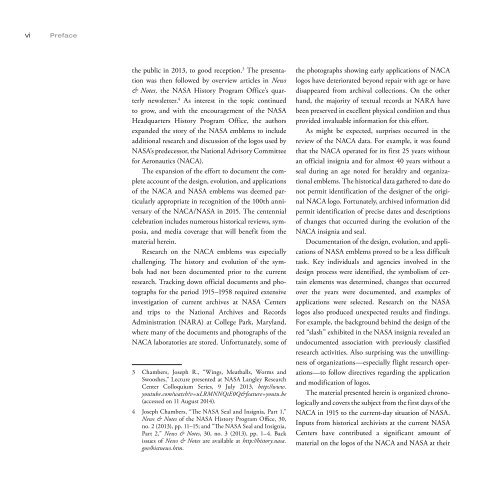Create successful ePaper yourself
Turn your PDF publications into a flip-book with our unique Google optimized e-Paper software.
vi<br />
Preface<br />
the public in 2013, to good reception. 3 The presentation<br />
was then followed by overview articles in News<br />
& Notes, the NASA History Program Office’s quarterly<br />
newsletter. 4 As interest in the topic continued<br />
to grow, and with the encouragement of the NASA<br />
Headquarters History Program Office, the authors<br />
expanded the story of the NASA emblems to include<br />
additional research and discussion of the logos used by<br />
NASA’s predecessor, the National Advisory Committee<br />
for Aeronautics (NACA).<br />
The expansion of the effort to document the complete<br />
account of the design, evolution, and applications<br />
of the NACA and NASA emblems was deemed particularly<br />
appropriate in recognition of the 100th anniversary<br />
of the NACA/NASA in 2015. The centennial<br />
celebration includes numerous historical reviews, symposia,<br />
and media coverage that will benefit from the<br />
material herein.<br />
Research on the NACA emblems was especially<br />
challenging. The history and evolution of the symbols<br />
had not been documented prior to the current<br />
research. Tracking down official documents and photographs<br />
for the period 1915–1958 required extensive<br />
investigation of current archives at NASA Centers<br />
and trips to the National Archives and Records<br />
Administration (NARA) at College Park, Maryland,<br />
where many of the documents and photographs of the<br />
NACA laboratories are stored. Unfortunately, some of<br />
3 Chambers, Joseph R., “Wings, Meatballs, Worms and<br />
Swooshes,” Lecture presented at NASA Langley Research<br />
Center Colloquium Series, 9 July 2013, http://www.<br />
youtube.com/watch?v=uLRMNNQiE0Q&feature=youtu.be<br />
(accessed on 11 August 2014).<br />
4 Joseph Chambers, “The NASA Seal and Insignia, Part 1,”<br />
News & Notes of the NASA History Program Office, 30,<br />
no. 2 (2013), pp. 11–15; and “The NASA Seal and Insignia,<br />
Part 2,” News & Notes, 30, no. 3 (2013), pp. 1–4. Back<br />
issues of News & Notes are available at http://history.nasa.<br />
gov/histnews.htm.<br />
the photographs showing early applications of NACA<br />
logos have deteriorated beyond repair with age or have<br />
disappeared from archival collections. On the other<br />
hand, the majority of textual records at NARA have<br />
been preserved in excellent physical condition and thus<br />
provided invaluable information for this effort.<br />
As might be expected, surprises occurred in the<br />
review of the NACA data. For example, it was found<br />
that the NACA operated for its first 25 years without<br />
an official insignia and for almost 40 years without a<br />
seal during an age noted for heraldry and organizational<br />
emblems. The historical data gathered to date do<br />
not permit identification of the designer of the original<br />
NACA logo. Fortunately, archived information did<br />
permit identification of precise dates and descriptions<br />
of changes that occurred during the evolution of the<br />
NACA insignia and seal.<br />
Documentation of the design, evolution, and applications<br />
of NASA emblems proved to be a less difficult<br />
task. Key individuals and agencies involved in the<br />
design process were identified, the symbolism of certain<br />
elements was determined, changes that occurred<br />
over the years were documented, and examples of<br />
applications were selected. Research on the NASA<br />
logos also produced unexpected results and findings.<br />
For example, the background behind the design of the<br />
red “slash” exhibited in the NASA insignia revealed an<br />
undocumented association with previously classified<br />
research activities. Also surprising was the unwillingness<br />
of organizations—especially flight research operations—to<br />
follow directives regarding the application<br />
and modification of logos.<br />
The material presented herein is organized chronologically<br />
and covers the subject from the first days of the<br />
NACA in 1915 to the current-day situation of NASA.<br />
Inputs from historical archivists at the current NASA<br />
Centers have contributed a significant amount of<br />
material on the logos of the NACA and NASA at their


